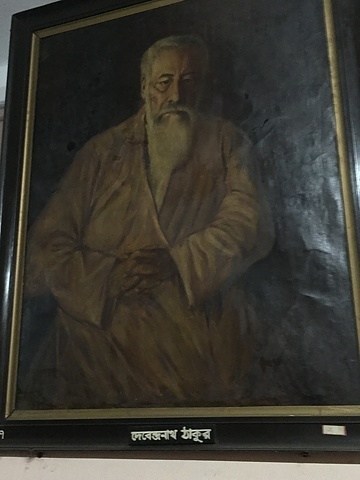Recording the possible disappearance of two works by Jamini Roy & Abanindranath Tagore.
Jamini Roy
What is not known to many, is that Jamini Roy was a successful portrait painter (a commissioned painter) in the early part of his career.
Repeating a quote from the Indian Museum in Kolkata, "His career as a painter started with portraiture. The realistic portraits of rich persons in oil revealed his technical mastery in western academic training and soon Jamini Roy earned
One of his most famous portraits is that of Debendranath Tagore - a reformer and founder of the Brahmo Samaj. The story goes that Abanindranath, Jamini's teacher, recruited him to make a copy of Debendranath Tagore's (Rabindranath Tagore's father) portrait as the original portrait by Sashi Hesh was withering away fast.
Apparently this work has gone missing from Bangiya Sahitya Parishad
These images are from the seminar room of the Bangiya Sahitya Parishad (Bengali Literature Academy). The original portrait - which has been previously photographed and even filmed and is not a figment of my imagination - a close up of Debendranath ( 3ft x 2 ft) - is missing.


Abanindranath Tagore

A pastel portrait of Rabindranath Tagore by Abanindranath Tagore documented in various places including in Andrew Robinson's book on Rabindranath Tagore. This was last seen at the Bosu Vigyan Mandir (Bose Institute)
Missing! With the people in charge claiming there was never such a work! Both the institutes mentioned above are historical institutes of great repute
Gaganendranath Replaced At Another Museum?
Similarly, there is another work of Gaganendranath at another museum that seems to be have been replaced. This is my observation and has not been independently verified and could very well be that the original has not been displayed for safe-keeping? Or this could very well be my mistake.
The reason why a Gaganendranath Tagore and some of these older works cannot be easily forged is partly due to the paper/medium used.
Hundred Year Old Paper
A note below on the reasons for my fixation on the mediums (paper/canvas/paints) used in an
An example - A registered cover from the princely state of Duttia (

But while these have been forged, determining the forgeries is quite easy - the medium, the type of paper used is key - a certain type of paper was used that is no longer available. And in keeping with the accepted norm of documenting forgeries but not fully mentioning why I refrain from talking about the type of paper.
If by some chance one does manage to get an old (correct type of) paper - writing/painting on an older paper with ink is not the easiest. The same applies to these older works of art - forgeries due to the medium and the
Speaking of Chai-
Wash Technique
As an example of Gaganendranath Tagore's work - look at the water and the sky, the
We have discussed papers and
Why do I mention this? Firstly, I mention this generally in regards to works of early Bengal and secondly that I find the paper in one of the works by Gaganendranath Tagore at the museum completely wrong and hence my suspicion.
Victoria Memorial also has a Jamini collection. Last month this gallery was under renovation and upon asking I was told the works have been temporarily stored in the "garage". I assume and hope that the person meant storage.
P.S. We sincerely hope that we have reached the wrong conclusions.
Related: Understanding Types of Prints
Image Credit
Self Taken,
Featured Image - Sandip Sarkars Book
Indian Museum On Jamini Roy
Bangiya Sahitya Parisharad (translated as Bengali Literature Center) - Beadon Street, Kolkata
Jamini Roy - His Life In Art - Sandip Sarkar


